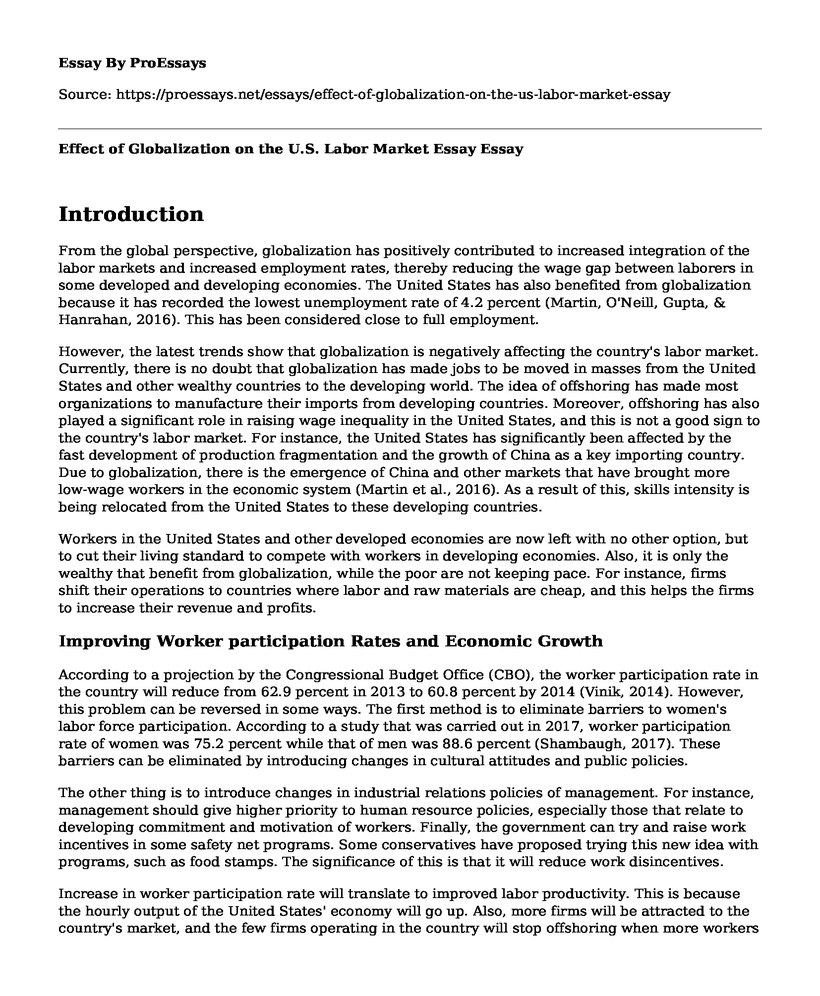Introduction
From the global perspective, globalization has positively contributed to increased integration of the labor markets and increased employment rates, thereby reducing the wage gap between laborers in some developed and developing economies. The United States has also benefited from globalization because it has recorded the lowest unemployment rate of 4.2 percent (Martin, O'Neill, Gupta, & Hanrahan, 2016). This has been considered close to full employment.
However, the latest trends show that globalization is negatively affecting the country's labor market. Currently, there is no doubt that globalization has made jobs to be moved in masses from the United States and other wealthy countries to the developing world. The idea of offshoring has made most organizations to manufacture their imports from developing countries. Moreover, offshoring has also played a significant role in raising wage inequality in the United States, and this is not a good sign to the country's labor market. For instance, the United States has significantly been affected by the fast development of production fragmentation and the growth of China as a key importing country. Due to globalization, there is the emergence of China and other markets that have brought more low-wage workers in the economic system (Martin et al., 2016). As a result of this, skills intensity is being relocated from the United States to these developing countries.
Workers in the United States and other developed economies are now left with no other option, but to cut their living standard to compete with workers in developing economies. Also, it is only the wealthy that benefit from globalization, while the poor are not keeping pace. For instance, firms shift their operations to countries where labor and raw materials are cheap, and this helps the firms to increase their revenue and profits.
Improving Worker participation Rates and Economic Growth
According to a projection by the Congressional Budget Office (CBO), the worker participation rate in the country will reduce from 62.9 percent in 2013 to 60.8 percent by 2014 (Vinik, 2014). However, this problem can be reversed in some ways. The first method is to eliminate barriers to women's labor force participation. According to a study that was carried out in 2017, worker participation rate of women was 75.2 percent while that of men was 88.6 percent (Shambaugh, 2017). These barriers can be eliminated by introducing changes in cultural attitudes and public policies.
The other thing is to introduce changes in industrial relations policies of management. For instance, management should give higher priority to human resource policies, especially those that relate to developing commitment and motivation of workers. Finally, the government can try and raise work incentives in some safety net programs. Some conservatives have proposed trying this new idea with programs, such as food stamps. The significance of this is that it will reduce work disincentives.
Increase in worker participation rate will translate to improved labor productivity. This is because the hourly output of the United States' economy will go up. Also, more firms will be attracted to the country's market, and the few firms operating in the country will stop offshoring when more workers are added to the economic system (Cebula & Alexander, 2015). This is because there will be readily available workforce. As a result of this, the real domestic product of the country will increase, thereby signifying an economic growth.
References
Cebula, R. J., & Alexander, G. (2015). An exploratory Empirical Note on the Impact of Labour market Freedom on the Female Labour Force Participation Rate in the US. Applied Economics Letters, 22(8), 632-636.
Martin, D., O'Neill, J., Gupta, N., & Hanrahan, B. V. (2016). Turking in a Global Labour Market. Computer Supported Cooperative Work (CSCW), 25(1), 39-77.
Shambaugh, J. (2017). Removing Barriers to Women's Labor Force Participation. Retrieved from https://www.brookings.edu/opinions/removing-barriers-to-womens-labor-force-participation/
Vinik, D. (2014). Labor Force Participation Is Falling - Here Are Five Ways to Fix It. Retrieved from http://www.businessinsider.com/our-labor-force-is-shrinking-here-are-five-ways-to-fix-it-2014-2?IR=T
Cite this page
Effect of Globalization on the U.S. Labor Market Essay. (2022, Jun 19). Retrieved from https://proessays.net/essays/effect-of-globalization-on-the-us-labor-market-essay
If you are the original author of this essay and no longer wish to have it published on the ProEssays website, please click below to request its removal:
- Do You Think the Texas Governor Should Be Limited to Serving Two Four-Year Terms?
- California Laws Essay Example
- Is Newark a New York City Suburban? Essay Example
- Issues Relating to Foreign Business Operations in South Africa Essay Example
- Capitalism: Harnessing Energy to Address Society's Challenges - Essay Sample
- Essay Example on Frederick Douglass: Impact on US History Amidst Major Events
- Elderly Targeted by Identity Theft - Free Essay Example







